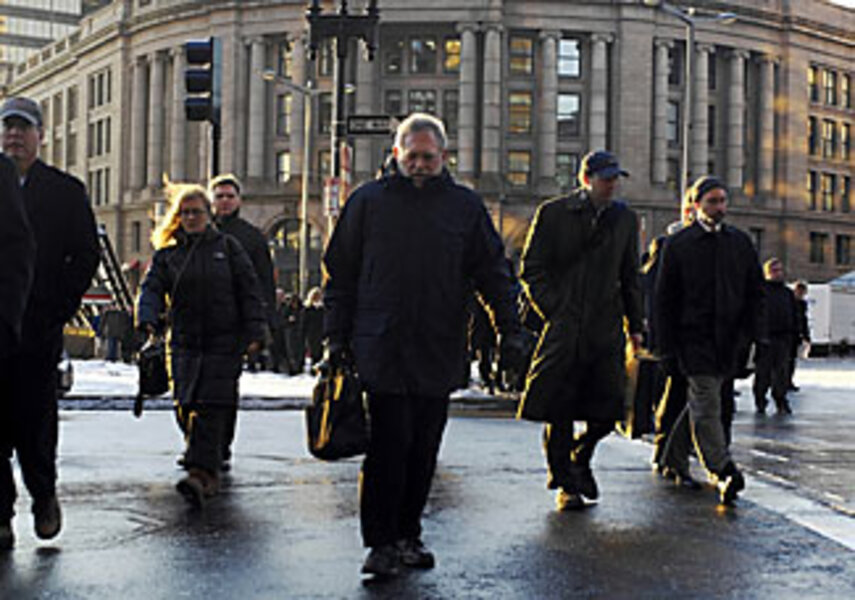Jobless claims overwhelm state offices
Loading...
| New York
Officials at state unemployment offices say they've never seen anything like it: Layoffs are happening so fast that those seeking unemployment benefits are overloading state computer systems, jamming phone lines, and making it necessary for administrators to hire temporary workers.
In some states, it's so bad officials suspect that only half the calls are getting through. Frustrated, the unemployed are e-mailing anyone they can find at the state agencies or are just hitting redial on their phones, sometimes hundreds of times. The problem will get worse before it gets better, say some officials.
"For the last six weeks, we have seen the highest [number of] weekly claims since we've been keeping records in 1985," says Mike Cullen, Colorado's unemployment insurance director.
"And they are increasing at an increasing rate," Mr. Cullen says.
Last Friday, some of this surge at state offices was reflected in the Department of Labor's monthly jobs report: In December, it said, the unemployment rate hit 7.2 percent, up from 6.7 percent in November. And employers shed 524,000 workers after letting go of 584,000 in November.
The job-loss total for all 2008 was 2.6 million, the most since 1945.
"What we are seeing is a portrait of an economy that is cratering," says Stuart Hoffman, chief economist at PNC Financial Services in Pittsburgh. "This explains why holiday sales were so weak, with people so concerned about their jobs, and why consumer confidence is so low."
Usually, if individuals qualify for unemployment insurance, they go online to apply or call their state bureau responsible for processing the paperwork and paying them. However, even the online networks are having challenges. Last week, three states – Ohio, North Carolina, and New York – reported computer problems. Online systems in many other states are slowing because of the sheer volume they are handling.
Although many states have offices to help individuals look for jobs, the state employees there usually cannot help someone applying for benefits.
"We let [the employees] do a simple task on [the office's] behalf, but we don't want them to give out bad information," says Cullen, whose state no longer has offices for those filing for benefits.
Yet many times, the unemployed need to talk to a real person.
That was the case last week for Danielle Saxon of Elk Grove, Calif., a suburb of Sacramento. In October, she lost her job at a company that does home renovation. But her claim form disappeared in the mail, and for two weeks, she was unable to get through to anyone in the state Employment Development Department (EDD).
Finally, after missing two unemployment checks, she drove to a state office with six phones that would ring through directly to state workers. As she waited in line to use one of the phones, she tried to reach someone on her cellphone – in 86 separate calls.
After two hours and 45 minutes, she finally got to use one of the six phones, but she had to redial 115 times to get through to a state employee.
"I am very frustrated. I have a car payment, car insurance, and a phone bill all overdue," she says. "What am I supposed to do?"
Her story is similar to ones elsewhere. In Ohio, the Department of Job and Family Services ordinarily handles about 7,500 calls a day. Two weeks ago, it started getting 80,000 calls a day, says Brian Harter, a spokesman.
To deal with the deluge, some states are trying to hire more workers. That's the case in Pennsylvania, which this past fall started hiring 600 permanent workers and 300 temps to help it cope with a 16.4 percent increase in new claims. In addition, the state is spending more money on its computer systems. "Our servers have been upgraded and expanded, and we are now upgrading our mainframe," says David Smith, a spokesman in Harrisburg, Pa.
In addition, Pennsylvania, which may see a big boost in claims after Alcoa lays off 15,000 workers, has expanded the hours of its workers in the unemployment office. Filers can even reach state workers on Sundays.
Although claims are high nationally, they are not at their peak – reached in 1982 when 695,000 people filed initial claims for unemployment in one month.
But in prior downturns, there were more offices for people to visit to get questions answered. In fact, the states could use an extra $546 million to administer their programs, estimates the National Association of State Workforce Agencies (NASWA).
"The problem is lack of resources [to hire] more employees and [modernize] computer systems," says Rich Hobbie, executive director.
For the past two years, Rep. Jim McDermott (D) of Washington has sponsored the Unemployment Insurance Modernization Act, which includes $7 billion to expand coverage and a one-year, $500 million payment to states to improve administration. Several press reports indicate the legislation is expected to be included in President-elect Obama's economic stimulus program. It was already reintroduced last Thursday in the House.
The states, however, are split over supporting it because it would require the expansion of coverage to include such categories as some part-time workers, people who have compelling family emergencies, and workers enrolled in state training programs.
Some Republicans say they are opposed to the expansion. Some business groups, concerned their unemployment costs will rise in the future, are also against it.
Unemployment advocates, however, say the basic unemployment act, written in 1935, needs updating. "It is woefully out of date," says Andrew Stettner of the National Employment Law Project in New York. "It will give the states an immediate boost to fill a gap in their unemployment insurance programs."






